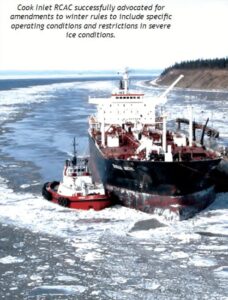Evaluating oil spill risks to Cook Inlet is a complex task. Cook Inlet RCAC has approached this by assessing vessel traffic; facility operations; oceanographic, environmental, and pipeline conditions; by evaluating response equipment, personnel and training for oil spill response; and by assisting state and federal efforts to conduct and administer navigational and infrastructure risk assessments that address Cook Inlet’s unique conditions. Highlights to date include:
- Participated in a Cook Inlet Platform Structural Integrity Study that assessed risk potential for personnel injury and damage to the environment.
- Conducted a Platform Facility Evaluation that documented basic well and safety systems of Cook Inlet platforms.
- Participated in the Navigational Safety Committee.
- Compiled a Cook Inlet Oil Facilities Inventory that detailed operations connected with exploration, production, processing, transport, and storage of crude and non-crude petroleum in Cook Inlet.
- Participated on Cook Inlet Tug Escort Work Group to evaluate whether OPA 90 requirements for escort tugs for single-hulled tankers could, or should, be applied to Cook Inlet. Cook Inlet RCAC was commended by several organizations for its role in convincing industry to voluntarily place an assist tug at Kenai Pipe Line dock.
- Participated as a panelist on The Ports and Waterways Safety Assessment Workshop aimed at identifying potential improvements to Cook Inlet Traffic Management System.
- Hosted Safety of Navigation Forums in 1999 and 2007 that resulted in a call for a comprehensive Cook Inlet navigational risk assessment.
- Sponsored a Cook Inlet forum to discuss conditions of pipelines in Cook Inlet that led to a request for a state funded Cook Inlet Pipeline Risk Assessment.
- Coordinated a working group of experts to conduct a needs assessment on human factors in safe navigation. The group identified 68 issues related to manning, qualifications, licensing, automation and work design, safety methods and data, communications, and organizational practices. This was instrumental in promulgating the first training requirements for Marine Pilots in Alaska.
- Produced an ice condition report for Cook Inlet that recognized the need to incorporate winter conditions in contingency plans and to set operational limits for severe ice conditions.
- Sponsored an ice symposium to identify navigational problems and potential technological solutions and advocated for amendments to winter rules to include specific operating conditions and restrictions in severe ice conditions.
- Designed and deployed an ice camera network that allows the National Weather Service ice forecaster to observe real-time ice conditions at several important locations in upper Cook Inlet.
- Produced a white paper on Dismantlement, Removal, and Restoration (DR&R) that summarized the state of statutes, regulations, leases, traffic, and liability issues inherent to DR&R.
- Participation by staff and Board members on Committees of ASTM International, a globally recognized leader in the development of international voluntary consensus standards.











